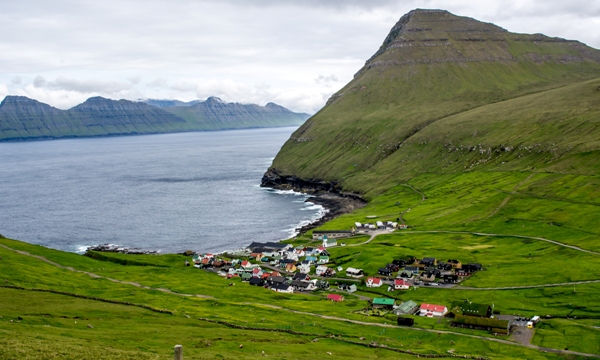Take a walk for more than a few minutes in the Faroe Islands and you’re guaranteed to come up against a big hill. The terrain of the 18 islands of this sub-Arctic archipelago is so uneven that pretty much anywhere offers a view of an intimidating mountain above and the Atlantic Ocean below. That they managed to find space to squeeze in an airport on one of the islands is quite an achievement.
These volcanic dots in the ocean, formed around 55 million years ago when Europe and Greenland separated, are home to a surprising number of challenging walking trails, and from most villages there’s a path which will, with a bit (or a lot) of effort, reward amply with a fabulous view when you reach the highest point. Many of these trails are old routes used by shepherds or farmers, cutting sharply up the sides of mountains and dropping into settlements far too small to warrant being called a village.
On our recent visit to the Faroes we tried to explore at least one of these trails each day, and soon we became addicted; I can’t be sure whether it was the pain of the climb or the pleasure of the view that had us coming back for more. On Eysturoy, the second largest of the Faroese islands, we stopped for the night in Gjaargardur, the only guesthouse in the remote village of Gjógv to the north of the island. The drive to reach Gjógv had been spectacular and we had stopped every other minute to photograph the constantly changing landscape; after all, the sun was shining and that’s an opportunity you can’t afford to waste in the Faroe Islands.
Gjógv is a modest settlement with a population of 49, with a tiny harbour and a few houses wedged in between towering cliffs on either side. With a helping hand from the guesthouse owner and the dangling reward of cake in the cafe on our return, we set off up the hillside to the west of the village. The climb was unforgiving, and our pace slowed quickly as we puffed and panted our way upwards. We followed the contour of the cliff, although with the wind blowing we kept a safe distance from the sheer drop at the edge. We stopped to rest and to watch puffins as they made circles above us, flapping their tiny wings as if they were in a desperate hurry. Kittiwakes also swooped overhead, and we kept one eye on the birds and another on the ever-growing drop.
Eventually we reached what we decided would be our summit (climbing any further would have just been showing off). We looked back and saw the tiny form of Gjógv far below. It was a view which more than rewarded our efforts, and we sat for a while in satisfied silence, slowly getting our breathe back. Only the thought of the waiting cake eventually pulled us away to start our careful descent down the hillside toward the village.
by Andy Jarosz





